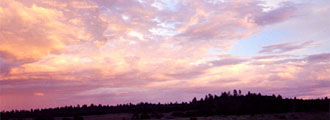"Trees
turned to stone" is one description of the Petrified
Forest National Park. In 1906 various forests were selected,
purchased and set aside as the Petrified Forest National Monument.
Over the years the park expanded and in 1962 the Monument
became a National Park. Visitors will be pleased to find the
Park currently includes part of the Painted Desert, Indian
Ruins, and Petroglyphs. The Petrified Trees were former Schilderia,
Woodworthia, and Araucaria trees.
Location: Northeastern Arizona, approx. 18-20 miles east of Holbrook,
Arizona between I-40 and Highway 180. From Phoenix approx.
4.5-5 hours. Please note times will vary depending on conditions
and route.
Please
note: it is ILLEGAL to remove Petrified Wood from
the Park. Stiff fines and penalties will result. For visitors
desiring to acquire Petrified Wood, park concessions and shops
near the park (Holbrook) sell Petrified Wood. Vehicles are
subject to search.
Painted
Desert Visitor Center: Film and exhibits
Tiponi Point: Painted Desert View
Point
Tawas and Kachina Points and Rim Trail:
View Points of the Painted Desert. Kachina Point is the Jumpoff
point for the Onyx Bridge Hike. (4 miles round trip) to see
a Petrified Log which spans a small wash.
Painted Desert Inn National Historic
Landmark: Built in 1924 and located at Tawas Point. Renovated
by CCC in the 1930's
Chinde Point: Painted Desert View Point
Pintado Point: Painted Desert View Point
Nizhoni Point: Painted Desert View Point
Whipple Point: Painted Desert View Point
Lacey Point: Painted Desert View Point
Puerco Pueblo: One of the Pre-Colombian
Ruins found inside the Park. It is a 100 room pueblo. Petroglyphs
are present. When the Spaniards arrived in the 1500's this
was abandoned.
Newspaper
Rock: Boulders covered with petroglyphs.
Note: Binoculars are recommended here as visitors are not
permitted to get close to the Petroglyphs. A viewing point/station
was present as of this writing.
The Tepees: Multi-hued/colored formations
inside the park. The colors are caused by minerals such as
manganese, and iron. Cap is usually clay. Dark layers have
high Carbon content. Some of the reddish colors are due to
iron oxide.
Blue Mesa and Blue Mesa Trail: Three mile
loop road with views, log falls, and a pedestal log. Trail
goes into the Badlands.
Agate Bridge: A petrified log spanning
a small chasm. Note this has been stabilized.
Jasper
Forest: More Petrified logs
Crystal Forest: 3/4 mile loop (1.4/1/5
kilometer loop) Here cracks in the petrified logs once held
clear and purple (amethyst) quartz crystals.
Long Logs: Easy 1/2 mile ( .9/1 kilometer)
trail through a large concentration of Petrified Wood.
Agate House: Trail to a Pre-Colombian
Ruin which has been partially restored. The ruin is built
of Petrified Wood. Approx. .8 mile.
Rainbow Forest Museum: Exhibits on Petrified
Wood and other items including a Phytosaur (ancient croc)
which used to live in the area.
Giant Logs: Enter at the Rainbow Forest
Museum. The parks longest log is located here. Short paved
trail with a few stairs. Just under 1/2 mile.
Photography: For those wanting good pictures of the
Painted Desert, early morning and evening hours (before the
sun goes down) seem to bring out the best hues.
Climate: Keep in mind this is high desert. Summer time temperatures can easily
exceed 100 degrees Fahrenheit (38 degrees Celsius) Carry sufficient
water! Watch for lightning and flash floods.
|




